Asta Nielsen



Franz Peffer , around 1920, printed by Meissner & Buch , Leipzig; owned by the Museum of Modern Art (MomA)
Asta Nielsen (born September 11, 1881 in Copenhagen , † May 25, 1972 in Frederiksberg ; full name Asta Sofie Amalie Nielsen ) was a Danish actress .
life and work
Asta Nielsen grew up in Sweden and Denmark. Her father Jens Christian Nielsen was an often unemployed blacksmith who died when Asta was 14 years old, while her mother Ida Frederikke Petersen was a laundress. She came into contact with the theater as a child. Their illegitimate daughter, Jesta, was born in 1901. From 1902 she was permanently employed in Copenhagen.
Her first film, Afgrunden (1910), brought her and the director Urban Gad a contract to produce several films in Germany, which was extended to 1915 due to the success that began. She initially shot exclusively under the direction of Urban Gad, whom she married in 1912. The professional collaboration ended in 1915, and the divorce took place in 1918.
The extraordinary success of Asta Nielsen with the audience made it possible for her producers to produce full-length film series for the international markets from 1911 and to market them with exclusive performance rights. In view of the short film programs still predominant in the cinemas and the resulting viewing habits, this represented a risk and aimed to lure the more discerning theater audience into the cinemas.
Most of their roles were conflict-laden women whose behavior did not correspond to social conventions, for example in The Foreign Bird (1911) and The poor Jenny (1912). Nielsen also had a talent for comic roles and was so successful with the audience, especially in Engelein (1914), that a sequel was made.
In 1916 she went back to Denmark and only returned to Germany after the end of the First World War , where from then on she appeared mainly in literary films and dramas. Between 1920 and 1922 she produced three films herself. Including a film adaptation of Shakespeare's Hamlet , in which she plays the Prince of Denmark. According to the theory advocated in the film, Hamlet was a princess who was raised as a male heir to the throne, which should explain his / her dismissive attitude towards Ophelia, but in truth should rather help Asta Nielsen to an interesting role. Her portrayal of women at the bottom of society in Die joudlose Gasse (1925) by Georg Wilhelm Pabst and Dirnentragödie (1927) by Bruno Rahn is also outstanding .
Asta Nielsen was the big star of silent films , in fact the first female movie star in the history of cinema in which she can be considered one of her first sex symbols . Asta Nielsen never let herself be tied to one subject : she played both broken, suffering women and prostitutes ; Dancers as well as simple workers. Her body language was always subtle, but expressive.
Her film career ended with the sound film , she only appeared in one single, impossible love . Although she had a pleasant voice, her skillful expression was drowned in this new medium. She continuously refused film offers. From then on she devoted herself to the theater and published her autobiography The Silent Muse in 1946 . In 1963 she was awarded the Filmband in Gold for her many years of outstanding work in German film. In 1968 an autobiographical documentary film that she produced was released.
Asta Nielsen died in 1972 and was buried in an anonymous communal grave at Vestre Kirkegård (West Cemetery) in Copenhagen.
In September 2010 she was honored with a star on the Boulevard der Stars in Berlin .
family
Asta Nielsen was married a total of six times. All marriages were childless, but she had an illegitimate daughter Jesta (1901–1964), who was married to the Danish painter, graphic artist and singer Paul Vermehren (1904–1964). In 1911 she married the businessman Alfred Schendel von Pelkowski (* 1878) in Berlin . After the divorce, she married the director Urban Gad (1879–1947) in 1912, and they divorced in 1915. This was followed by marriages with Sven Gade and the actor Grigori Chmara . In 1919 she married the Swedish producer Freddy Wingaardh , this marriage divorced in 1927. Her sixth and last was Christian Theede (1899–1988), who was a gardening owner, art dealer and gallery owner on the island of Møn .
Asta Nielsen House
Asta Nielsen owned a house from 1929 on the German Baltic Sea island of Hiddensee , which she called "Karusel" (Danish name for carousel). The name is derived from two clearly rounded corners of the square floor plan of the building. She often spent several months there in the summer with her daughter and her husband. The friends and acquaintances who visited her there included Joachim Ringelnatz with his wife, Heinrich George and Gerhart Hauptmann . After 1935 or 1936 she no longer used the house.
The house by the architect Max Taut , built in 1923, was listed as a historical monument in 1975. Her heirs sold it to the community in 1989. In 2015 it was opened as the “Asta Nielsen House” and also contains an exhibition on Asta Nielsen.
Movies
Silent films

- 1910: Abysses (Afgrunden)
- 1911: hot blood
- 1911: Moths
- 1911: The Black Dream (Den Sorte drøm)
- 1911: In the big moment
- 1911: Gypsy blood
- 1911: ballet dancer (Balletdanserinden)
- 1911: The strange bird
- 1911: The traitor
- 1912: The power of gold
- 1912: Poor Jenny
- 1912: Chased to death
- 1912: The Dance of Death (fragment)
- 1912: The general's children
- 1912: When the mask falls
- 1912: The girl without a fatherland
- 1912: youth and madness
- 1912: Death in Seville - Director: Urban Gad
- 1913: comedians
- 1913: The sins of the fathers
- 1913: The Suffragette
- 1913: S1
- 1913: The film prima donna
- 1914: Engelein
- 1914: The child calls
- 1914: Zapata's gang
- 1914: The Fire - Director: Urban Gad
- 1914: The wrong Asta Nielsen
- 1914: White Roses - Director: Urban Gad
- 1914: The Eternal Night
- 1915: front stairs - back stairs
- 1916: Engeleins wedding
- 1916: The ABC of love
- 1916: Dora Brandes
- 1916: In the vortex of life
- 1916: Cinderella
- 1916: The Eskimo Baby - Director: Walter Schmidthäusler
- 1917: The guinea pig - Director: Edmund Edel
- 1918: The Eskimo Baby
- 1918: The stock exchange queen
- 1919: Intoxication
- 1919: The End of the Song - Director: Willy Grunwald
- 1919: According to the law
- 1919: The torchbearer (Mod lyset)
- 1920: The dance
- 1920: Mata Hari - Director: Ludwig Wolff
- 1920: Kurfürstendamm
- 1920: Helmsman Holk
- 1921: Hamlet
- 1921: Errende Seelen - Director: Carl Froelich
- 1921: Miss Julie
- 1921: Rosvolsky's mistress
- 1922: Vanina
- 1922: The dancer Navarro
- 1922: The crash
- 1923: Earth Spirit
- 1923: The house by the sea
- 1923: INRI
- 1924: The woman in the fire
- 1924: The butterfly battle
- 1925: Hedda Gabler
- 1925: Living Buddhas
- 1925: The joyless alley
- 1927: Vice of humanity
- 1927: Whore tragedy
- 1927: harassed women
- 1927: small town sinner
- 1927: The dangerous age
Sound films
- 1932: Impossible love
- 1968: Asta Nielsen (documentary) - Director: Asta Nielsen
Theater (selection)
- 1905: Alexander the Great, Christiana
- 1908: The beautiful woman from Marseilles, New Theater in Copenhagen
- 1925: The Lady of the Camellias, Schauspielhaus Leipzig
- 1926: Rita Cavallini, Friedrichtheater Dessau
- 1933: Gentlemen, Theater am Kurfürstendamm Berlin
- 1939: Tony draws a horse, Folketeatret Copenhagen
Asta Nielsen cinema library
In 2000, the Asta Nielsen cinema was founded in Frankfurt am Main through an initiative by filmmakers, curators, critics, students, historians and film lovers . The Kinothek is an association that has set itself the task of documenting women's film work and bringing it back to the cinemas, and its work follows on from the feminist film work of the 1970s and 1980s. Karola Gramann has been the artistic director of the Kinothek Asta Nielsen since 2006 .
The Kinothek dedicated several retrospectives to its namesake.
literature
- Andreas Hansert: Asta Nielsen and the film city Babelsberg. Carl Schleussner's involvement in the German film industry. Michael Imhof, Petersberg 2007, ISBN 978-3-86568-232-1 .
- Jürgen Kasten: Nielsen, Asta Carla Sofie Amalie. In: New German Biography (NDB). Volume 19, Duncker & Humblot, Berlin 1999, ISBN 3-428-00200-8 , p. 230 ( digitized version ).
- Asta Nielsen: The silent muse - memories. Carl Hanser, Munich 1977, ISBN 3-446-12420-9 .
- Hans Schifferle: magic of the body. "Dance of Death" with Asta Nielsen (1912). In: Peter Buchka (Ed.): German moments. A sequence of images on a typology of the film (= "Off" texts. Vol. 1). Belleville, Munich 1996, ISBN 3-923646-49-6 , p. 10 f. (first: Süddeutsche Zeitung 1995).
- Renate Seydel, Allan Hagedorff (eds.): Asta Nielsen . A biography. Your life in photo documents, self-testimonies and contemporary reflections. Designed by Bernd Meier and provided with a foreword by Svend Kragh-Jacobsen. 1st edition. Henschelverlag Kunst und Gesellschaft, Berlin (GDR) 1981. 263 pages, with b / w illus. (LSV-Nr. 8414, 625284 4) (2nd edition. Ibid. 1984).
- Renate Seydel (Ed.): Asta Nielsen. 1881-1972. A life between Copenhagen - Berlin and Hiddensee. Demmler Verlag, Ribnitz-Damgarten 2011, ISBN 978-3-910150-86-7 .
- Günter Helmes : "Lower the flag in front of her, because she is incomparable and unmatched." Approaches to Asta Nielsen, the first 'star' in film history. In: Yearbook on Culture and Literature of the Weimar Republic, Vol. 17, 2015/16, pp. 47–73.
- Barbara Beuys: Asta Nielsen: Filmgenie und Neue Frau , Berlin: Insel Verlag, 2020, ISBN 978-3-458-17841-5
documentary
- Asta and "Charlotte" - a film star in the Ruhr area , WDR Cologne 1990, script and direction: Paul Hofmann and Heinz Trenczak
Web links
- Literature by and about Asta Nielsen in the catalog of the German National Library
- Asta Nielsen in the Internet Movie Database (English)
- Asta Nielsen. In: FemBio. Women's biography research (with references and citations).
- Christina Hoor: Asta Nielsen. Tabular curriculum vitae in the LeMO ( DHM and HdG )
- The star of the silent film - Asta Nielsen private website
- Asta Nielsen at filmportal.de
- Bio- and filmography ( memento from April 6, 2016 in the Internet Archive ) on film-zeit.de
- Pictures by Asta Nielsen In: Virtual History
- "Importing Asta Nielsen". Database - Collection of articles and advertisements from trade and local newspapers worldwide
Individual evidence
- ↑ a b knerger.de: The grave of Asta Nielsen
- ↑ Renate Seydel (Ed.): Asta Nielsen. Your life in photo documents, self-testimonies and contemporary reflections. 1981, p. 33.
- ↑ Martin Loiperdinger: Asta Nielsen goes into series. The establishment of the film star as an international branded item between 1911 and 1914. In: Filmblatt No. 61/62 (2017), pp. 3–23.
- ↑ (da) grave of Asta Nielsen
- ↑ history of the house on www.asta-nielsen-haus.de
- ↑ LANGUAGE OF LOVE. ASTA NIELSEN, YOUR FILMS, YOUR CINEMA 1910–1933 ( Memento from June 23, 2016 in the Internet Archive )
| personal data | |
|---|---|
| SURNAME | Nielsen, Asta |
| ALTERNATIVE NAMES | Nielsen, Asta Sofie Amalie (full name) |
| BRIEF DESCRIPTION | Danish actress |
| DATE OF BIRTH | September 11, 1881 |
| PLACE OF BIRTH | Copenhagen |
| DATE OF DEATH | May 25, 1972 |
| Place of death | Frederiksberg |



